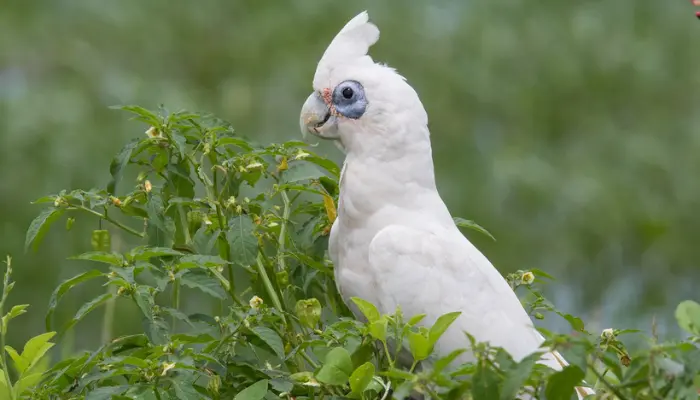The Blue-eyed Cockatoo emerges as a captivating enigma of the avian world within the lush rainforests of Australia. This majestic bird commands attention and admiration due to its striking cobalt gaze and radiant plumage. These magnificent birds with their snow-white plumage and playful personalities are a marvel of the avian world. But beneath their beauty lies a vulnerability.
This bird was classified as “Vulnerable” by the IUCN. The Blue-eyed Cockatoo like black palm cockatoos faces threats to its survival. In this article, we will explore the fascinating world of the Blue-eyed Cockatoo, its unique characteristics, habitat, care, and diet.
Origin and History of Blue-eyed Cockatoo
The blue-eyed cockatoo scientifically known as Cacatua ophthalmica which was first documented in the early 19th century by Heinrich Kuhl. This species inhabits forests and wooded areas of Indonesia particularly the northern Moluccas region where it can be found in small flocks. Its most notable features are its stunning blue eyes which stand out against its predominantly white plumage complemented by a yellow crest and orange cheek patches.
The blue-eyed cockatoo faces significant threats from habitat loss due to deforestation and illegal trapping for the pet trade. Now its classification as Vulnerable on the IUCN Red List of Threatened Species. While not as commonly kept as pets as some other cockatoo species, responsible breeding efforts are underway in captivity to ensure genetic diversity and sustainability.
Conservation initiatives aim to protect remaining wild populations through habitat preservation, anti-poaching measures, and community education. The blue-eyed cockatoo serves as a poignant reminder of the importance of safeguarding biodiversity and preserving the natural habitats of vulnerable species.
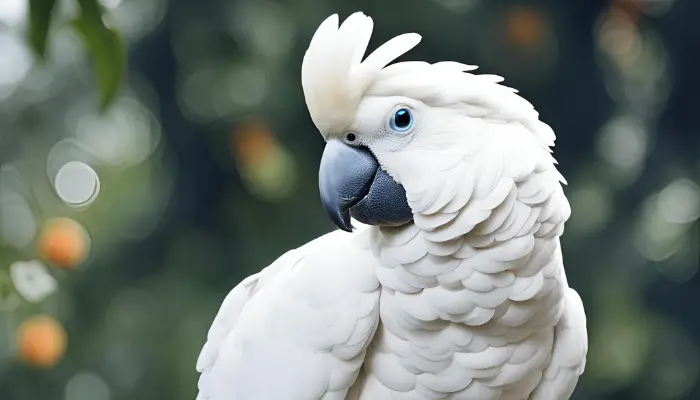
Scientific Classification of Blue-eyed Cockatoo
The blue-eyed cockatoo also known as the blue-eyed sulphur-crested cockatoo or Cacatua ophthalmica and its scientific classification is as follows.
| Kingdom | Animalia |
| Class | Aves (birds) |
| Family | Cacatuidae |
| Scientific Name | Cacatua ophthalmica |
| Common Name | Blue-eyed Cockatoo |
| Bird Size | The Blue-eyed Cockatoo is a medium-sized cockatoo, typically measuring around 45 to 50 centimeters (18 to 20 inches) in length. |
| Feather Color | The plumage of the Blue-eyed Cockatoo is predominantly white, with striking blue feathers encircling the eyes, lending it its distinctive name. |
| Crest Color | Similar to other cockatoos, the crest of the Blue-eyed Cockatoo is typically yellow. |
| Lifespan | Blue-eyed Cockatoos have a relatively long lifespan, often living between 40 to 60 years in captivity with proper care. |
| Price Range |
|
This classification places the blue-eyed cockatoo within the broader group of parrots specifically within the family Cacatuidae which includes cockatoos known for their distinctive crests and vocalizations.
Blue-eyed Cockatoo Colors and Marking
Blue-eyed cockatoos such as the stunningly beautiful blue-eyed cockatoo (Cacatua ophthalmica) are known for their striking appearance and distinctive features. Here is an overview of their colors and markings.
- Body Color: Blue-eyed cockatoos typically have predominantly white plumage covering their bodies. This white coloration serves as a canvas for the other vibrant colors on their bodies, making them stand out.
- Crest: Like other cockatoos, blue-eyed cockatoos have a prominent crest on top of their heads. This crest can be raised or lowered depending on the bird’s mood or level of excitement. The crest feathers are often lighter in color compared to the body plumage.
- Head and Face: The face of a blue-eyed cockatoo is adorned with vibrant hues, including bright yellow feathers around the eyes and on the cheeks. These yellow feathers contrast beautifully with the bird’s white plumage.
- Beak: The beak of a blue-eyed cockatoo is usually a dark gray or black color. This beak is powerful and well-adapted for cracking open nuts and seeds, which form a significant part of the bird’s diet.
- Blue Eyes: As their name suggests, blue-eyed cockatoos have stunning blue eyes, which add to their allure. The intensity of the blue color can vary slightly among individuals, but it is always a striking feature.
- Markings and Patterns: While the majority of their plumage is white, blue-eyed cockatoos may have subtle markings or patterns in different shades of white or light gray. These markings can include faint stripes or speckles on the feathers, especially on the wings and tail.
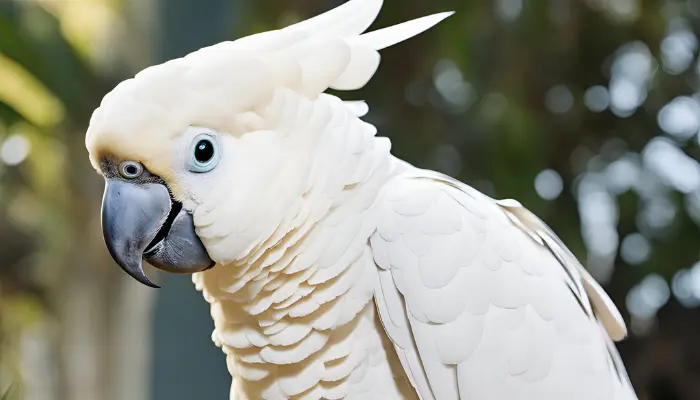
Caring Tips for Blue-eyed Cockatoo
Caring for a blue-eyed cockatoo requires attention to their specific needs to ensure they thrive in captivity. Here are some tips.
- Proper Diet: Blue-eyed cockatoos need a balanced diet consisting of high-quality pellets, fresh fruits, and vegetables. Avoid giving them foods that are toxic to birds, such as chocolate, avocado, and caffeine.
- Hydration: Ensure your cockatoo has access to clean, fresh water at all times. Cockatoos can be messy drinkers, so be prepared to change their water frequently.
- Social Interaction: Blue-eyed cockatoos are highly social birds and need plenty of mental stimulation and interaction. Spend time with your bird daily, engaging in activities like training, playtime, or simply talking to them.
- Cage Setup: Provide a spacious cage with plenty of room for your cockatoo to move around and stretch its wings. Include perches of different sizes and textures to keep their feet healthy, along with toys for mental stimulation.
- Regular Vet Check-ups: Schedule regular check-ups with an avian veterinarian to ensure your cockatoo remains healthy. Annual check-ups can catch any health issues early on.
- Grooming: Blue-eyed cockatoos produce a lot of feather dust, so regular grooming is essential. This can include baths, misting, or gentle wiping with a damp cloth to remove dust and keep their feathers clean.
- Training: Invest time in positive reinforcement training to teach your cockatoo basic commands and encourage desirable behaviors. This can strengthen your bond and provide mental stimulation for your bird.
- Respect Their Space: While cockatoos enjoy interaction, they also need downtime. Respect their need for rest and quiet, especially during their natural sleep hours.
- Environmental Enrichment: Provide a stimulating environment with toys, puzzles, and foraging opportunities to keep your cockatoo mentally engaged and prevent boredom.
- Be Patient and Understanding: Cockatoos are intelligent and sensitive birds that can form deep bonds with their caregivers. Be patient with them, understand their needs, and provide a loving and supportive environment.
By following these caring tips you can help ensure that your blue-eyed cockatoo lives a happy and healthy life in captivity.
Common Health Problems of Blue-eyed Cockatoo
Blue-eyed Cockatoos also known as Blue-eyed Cockatiels (Nymphicus hollandicus) which are a mutation of the common Grey Cockatoo. While they share many health concerns with their non-mutated counterparts There are some specific issues associated with the Blue-eyed Cockatoo mutation. Here are some common health problems that Blue-eyed Cockatoos may face.
- Respiratory Infections: Cockatoos are susceptible to respiratory infections, which can be exacerbated by environmental factors such as drafts or poor air quality. Blue-eyed Cockatoos may be particularly sensitive due to their genetic makeup.
- Feather Plucking: Feather plucking can be a behavioral issue in Cockatoos, including Blue-eyed varieties. This can be caused by stress, boredom, or medical issues such as skin irritation or infection.
- Nutritional Deficiencies: Inadequate diet can lead to various health problems in Cockatoos, including Blue-eyed Cockatoos. Ensure they receive a balanced diet rich in nutrients, including fruits, vegetables, seeds, and pellets.
- Obesity: Overfeeding and lack of exercise can lead to obesity in Cockatoos, which can predispose them to various health issues such as heart disease and joint problems.
- Psittacosis (Parrot Fever): Psittacosis is a bacterial infection that can affect parrots, including Cockatoos. It can cause symptoms such as respiratory distress, lethargy, and discharge from the eyes and nostrils.
- Beak and Nail Overgrowth: Cockatoos need regular beak and nail maintenance to prevent overgrowth, which can lead to discomfort and difficulty eating or perching.
- Aspergillosis: This is a fungal infection that can affect the respiratory system of birds. It can be caused by exposure to moldy environments or contaminated food and can be particularly problematic for birds with compromised immune systems.
- Polyoma Virus: This virus primarily affects young birds and can cause symptoms such as lethargy, weight loss, and feather abnormalities. Vaccination may be recommended for Blue-eyed Cockatoos to prevent infection.
- Egg Binding: Female Cockatoos, including Blue-eyed varieties, may experience difficulty laying eggs, which can lead to egg binding. This is a potentially life-threatening condition that requires immediate veterinary attention.
- Heavy Metal Toxicity: Cockatoos are prone to heavy metal toxicity if they ingest materials containing lead, zinc, or other toxic metals. Ensure their environment is free from such hazards.
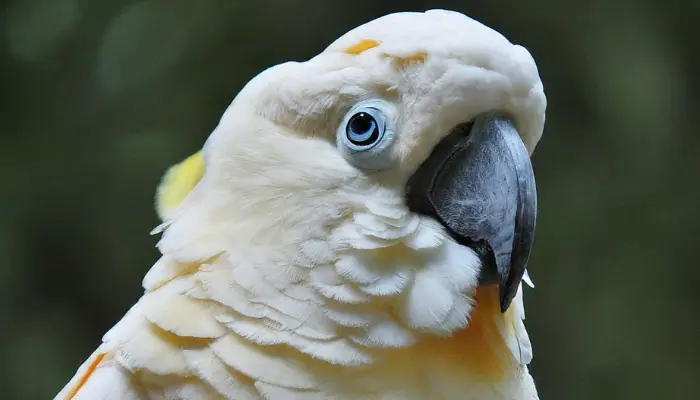
Best Diet for Blue-eyed Cockatoo
A proper diet is essential for the health and well-being of a blue-eyed cockatoo. Here is a general guideline for what you should include in their diet.
- Pellets: High-quality pellets specifically formulated for cockatoos should form the basis of their diet. These provide balanced nutrition and are designed to meet the bird’s dietary requirements.
- Fresh Vegetables: Offer a variety of fresh vegetables such as carrots, broccoli, spinach, kale, and bell peppers. These provide essential vitamins and minerals.
- Fresh Fruits: Include fruits like apples, oranges, bananas, grapes, and berries in their diet. Fruits offer natural sugars and additional vitamins.
- Grains and Seeds: Small amounts of whole grains and seeds can be offered as treats but should not make up the bulk of their diet due to their high-fat content. Examples include millet, quinoa, and whole wheat.
- Nuts: Nuts are high in fat and should be given sparingly, as occasional treats. Suitable options include almonds, walnuts, and unsalted peanuts.
- Calcium Sources: Provide calcium-rich foods like cuttlebone, eggshells, or calcium supplements to ensure proper bone health.
- Fresh Water: Always provide fresh, clean water for drinking.
Avoid feeding your cockatoo foods that are high in sugar, salt, or fat, as these can lead to health problems like obesity and nutritional deficiencies. Additionally, avoid feeding them avocado, chocolate, caffeine, and alcohol, as these are toxic to birds.
Top 10 Interesting Facts About blue-eyed Cockatoo
Blue-eyed Cockatoo is a fascinating bird species native to the rainforests of New Guinea and surrounding islands. Here are some interesting facts about them.
- Distinctive Appearance: Blue-eyed Cockatoos are known for their striking appearance, characterized by a vibrant blue eye-ring surrounding their dark eyes, which contrasts beautifully with their white plumage.
- Endangered Species: These cockatoos are classified as an endangered species due to habitat loss and illegal trapping for the pet trade. Conservation efforts are underway to protect their remaining populations.
- Intelligent Birds: Like other cockatoos, blue-eyed cockatoos are highly intelligent birds. They possess problem-solving abilities and can be taught various tricks and tasks, making them popular pets among bird enthusiasts.
- Social Creatures: Blue-eyed Cockatoos are social birds that form strong bonds with their flock mates. In the wild, they often gather in large flocks to forage for food and roost together at night.
- Vocal Communicators: These cockatoos are known for their loud and expressive vocalizations. They use a variety of calls to communicate with each other, including squawks, screeches, and whistles.
- Dietary Habits: Blue-eyed Cockatoos primarily feed on seeds, nuts, fruits, and berries found in their native rainforest habitats. In captivity, they also enjoy a diet supplemented with vegetables and commercial bird pellets.
- Longevity: With proper care, blue-eyed cockatoos can live for several decades. In captivity, they have been known to live for up to 50 years or more, making them long-term companions for their owners.
- Mating Rituals: During the breeding season, male blue-eyed cockatoos engage in elaborate courtship displays to attract a mate. These displays often involve fluffing up their feathers, bobbing their heads, and vocalizing loudly.
- Nesting Behavior: Blue-eyed Cockatoos typically nest in tree hollows, where the female lays a clutch of eggs. Both parents take turns incubating the eggs and caring for the chicks once they hatch.
- Conservation Efforts: Due to their declining populations, blue-eyed cockatoos are the focus of various conservation initiatives aimed at protecting their natural habitats and combating illegal trade. These efforts involve habitat restoration, captive breeding programs, and education campaigns to raise awareness about the plight of these beautiful birds.
These fascinating facts highlight the unique characteristics and conservation challenges facing the blue-eyed cockatoo.
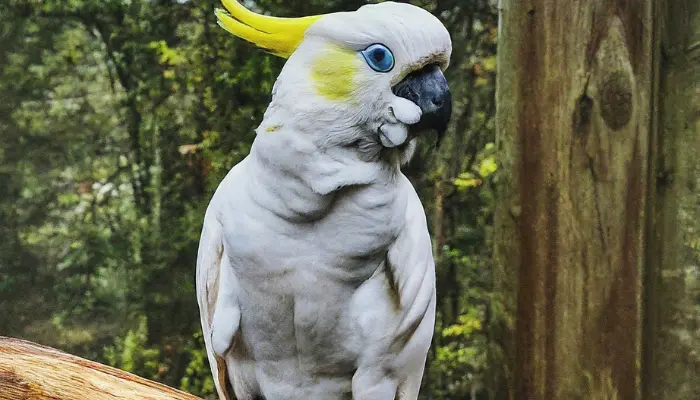
Where to Buy or Adopt a Blue-eyed Cockatoo
If you are looking to buy or adopt a blue-eyed cockatoo, there are a few options you can explore.
Avian Breeders
Look for reputable avian breeders who specialize in cockatoos. Ensure they have experience with breeding and caring for blue-eyed cockatoos specifically.
Avian Rescues and Shelters
Many bird rescues and shelters often have cockatoos available for adoption. It’s worth contacting them to see if they have any blue-eyed cockatoos in need of a loving home.
Online Classifieds and Forums
Websites and forums dedicated to bird enthusiasts often have classified sections where breeders and individuals advertise birds for sale or adoption. Be cautious and ensure the seller is reputable before making any transactions.
Some Pros and Cons to Keep a Blue-eyed Cockatoo as a Pet
Keeping a blue-eyed cockatoo as a pet can be a rewarding experience but it also comes with its own set of challenges. Here are some pros and cons.
| Pros | Cons |
| Beautiful Appearance: Blue-eyed cockatoos are stunning birds with striking blue eyes and vibrant plumage. Their beauty can be a major draw for bird enthusiasts. | Loud Vocalizations: Cockatoos are known for their loud vocalizations, which can be disruptive, especially in small living spaces or apartments. They may scream for attention or as a form of communication, which can be challenging for some owners to manage. |
| Intelligent: Cockatoos are highly intelligent birds and can be taught various tricks and commands. They enjoy mental stimulation and can form strong bonds with their owners through training and interaction. | Destructive Behavior: Blue-eyed cockatoos have powerful beaks and enjoy chewing and destroying objects. Without proper enrichment and stimulation, they may resort to destructive behaviors like chewing furniture or shredding household items. |
| Affectionate: Blue-eyed cockatoos are known for their affectionate nature. They often enjoy cuddling and being close to their owners, which can create a strong bond between bird and human. | Time and Attention: Cockatoos require a significant amount of time and attention from their owners. They thrive on social interaction and can become bored or develop behavioral issues if neglected. |
| Long Lifespan: With proper care, blue-eyed cockatoos can live for several decades, providing companionship for many years. | Messy: Like all birds, cockatoos can be messy pets. They produce feathers, dander, and droppings that require regular cleaning to maintain a hygienic living environment. |
| Social: Cockatoos are social creatures and enjoy being part of a family. They thrive on interaction and can become depressed if left alone for long periods. | Specialized Care: Blue-eyed cockatoos have specific dietary and environmental needs that must be met for their health and well-being. Owners must be prepared to provide a balanced diet, regular veterinary care, and a suitable living environment. |
keeping a blue-eyed cockatoo as a pet can be a fulfilling experience for the right owner who is willing to invest time, effort, and resources into their care. However, it is essential to thoroughly research the species and consider the potential challenges before bringing one into your home.
